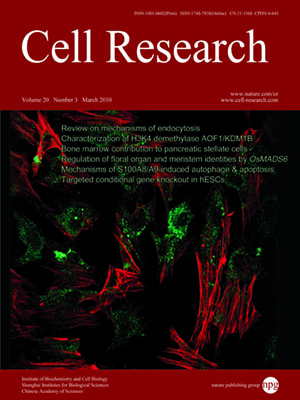
Volume 20, No 3, Mar 2010
ISSN: 1001-0602
EISSN: 1748-7838 2018
impact factor 17.848*
(Clarivate Analytics, 2019)
Volume 20 Issue 3, March 2010: 345-356
ORIGINAL ARTICLES
Up-regulation of divalent metal transporter 1 in 6-hydroxydopamine intoxication is IRE/IRP dependent
Hong Jiang, Ning Song, Huamin Xu, Shuzhen Zhang, Jun Wang and Junxia Xie
Department of Physiology, Shandong Provincial Key Laboratory of Pathogenesis and Prevention of Neurological Disorders and State Key Disciplines: Physiology, Medical College of Qingdao University, Qingdao 266071, China
Correspondence: Hong Jiang, Junxia Xie,(jhkyk@163.com; jxiaxie@public.qd.sd.cn)
Iron plays a key role in Parkinson's disease (PD). Increased iron content of the substantia nigra (SN) has been found in PD patients, and divalent metal transporter 1 (DMT1) has been shown to be up-regulated in the SN of both MPTP-induced PD models and PD patients. However, the mechanisms underlying DMT1 up-regulation are largely unknown. In the present study, we observed that in the SN of 6-hydroxydopamine (6-OHDA)-induced PD rats, DMT1 with the iron responsive element (IRE, DMT1+IRE), but not DMT1 without IRE (DMT1−IRE), was up-regulated, suggesting that increased DMT1+IRE expression might account for nigral iron accumulation in PD rats. This possibility was further assessed in an in vitro study using 6-OHDA-treated and DMT1+IRE-over-expressing MES23.5 cells. In 6-OHDA-treated MES23.5 cells, increased iron regulatory protein (IRP) 1 and IRP2 expression was observed, while silencing of IRPs dramatically diminished 6-OHDA-induced DMT1+IRE up-regulation. Pretreatment with N-acetyl-L-cysteine fully suppressed IRPs up-regulation by inhibition of 6-OHDA-induced oxidative stress. Increased DMT1+IRE expression resulted in increased iron influx by MES23.5 cells. Our data provide direct evidence that DMT1+IRE up-regulation can account for IRE/IRP-dependent 6-OHDA-induced iron accumulation initiated by 6-OHDA-induced intracellular oxidative stress and that increased levels of intracellular iron result in aggravated oxidative stress. The results of this study provide novel evidence supporting the use of anti-oxidants in the treatment of PD, with the goal of inhibiting iron accumulation by regulation of DMT1 expression.
Cell Research (2010) 20:345-356. doi: 10.1038/cr.2010.20; published online 2 February 2010
FULL TEXT | PDF
Browse 2388


